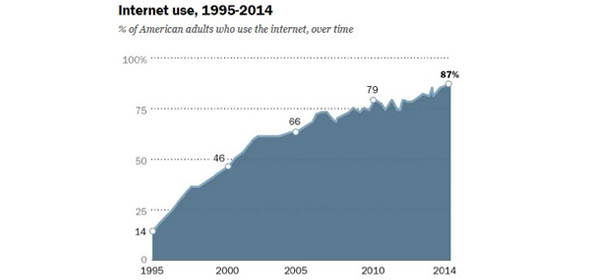
The internet has had a transformative impact on Americans’ lives, and libraries have taken that impact in stride, offering equipment, infrastructure, and navigation assistance sought by patrons across the country. To mark the 25th anniversary of the Web, Pew Research recently released new survey results that demonstrate the internet’s powerful role in our everyday lives.
We know internet use is wide-spread, with more than 4 in 5 adults using it. But some of the most interesting findings in this research are related to how we view the internet. Despite the vitriol and trolls lurking in comment areas, about 3 in 4 internet users thought interactions were mostly kind. More than half have seen an online group or community come together to solve a problem or help someone. Interestingly, younger internet users (18-29) tended to see more of the good and the bad sides of the internet—being treated kindly and unkindly themselves and seeing people come together and tear each other down—than older users.
Two-thirds say the web has strengthened relationships with family and friends. And more than half of internet users say the internet would be very hard to give up—still more than the 49% of cell phone owners who say the same thing about their phone! Importantly, of those who said the web would be hard to give up, most (61%) said the internet was “essential for job-related or other reasons.”
Of course libraries are well aware of these trends. Most have websites and the number of libraries that offer mobile-friendly websites is increasing accordingly as smartphone usage increases. And with new research breaking down library users and non-users by type, we can also understand the role technology plays in the lives of our users based on their engagement with our services. How has your library changed in the 25 years since the web was created?
Note: This post is part of our series, “The Weekly Number.” In this series, we highlight statistics that help tell the story of the 21st-century library.